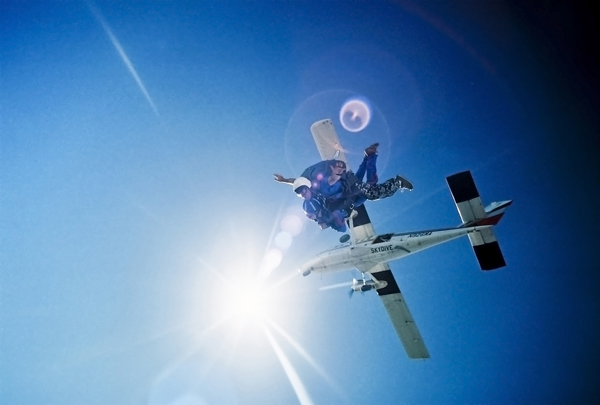How to Survive Falling From a Plane

Falling from or being sucked out of an airplane come under the rubric of improbable but intriguing terrors, the favored fodder of dime novels and breathless action flicks. Like being lost in the Sahara, cast adrift at sea or bitten by a deadly exotic creature, they are fascinating, if incredibly unlikely, fates, and we can’t help but wonder what we would do if we found ourselves in such dire straits.
Imagine you’re plummeting through the air, six miles up. Naught but your wits, pluck and a bit of luck stand between you and a speedy but abrupt reunion with Earth. You could probably use a little good news right now, so here it is: Thanks to wind resistance, your falling speed will top out at a dawdling 120 mph, depending on your size and weight, and local air density.
That’s about as fast as you’d smack into South Wacker Drive if you took a header off the Willis Tower (formerly the Sears Tower) in Chicago. But, whereas that one-way flight would clock in at 12 seconds from roof to sidewalk, your added altitude will grant you a leisurely three minutes or so in which to plan your day, contemplate the decisions that brought you to this desperate juncture and, most critically, develop a survival strategy.
Assuming, or course, that the freezing cold and lack of oxygen don’t kill you mid-fall, here are four simple steps you can try to soften your landing:
Step one: Don’t panic. Even if you initially pass out from lack of oxygen, you’ll probably come to in time to manage at least one of the following.
Step two: Adjust your posture into something resembling a skydiver’s flying squirrel pose. Make a flying X with your arms and legs, keep your chest down and arch your back and neck.
Step three: Aim. Avoid hard surfaces. Shoot for something with a bit of give, but don’t be fooled by water: It’s incompressible and, as any water skier will tell you, striking it at high speed resembles picking a fight with a sidewalk. Answer the sea’s siren song, and you might find that your broken body survives just long enough to drown.
Sign up for the Live Science daily newsletter now
Get the world’s most fascinating discoveries delivered straight to your inbox.
Haystacks, bushes, snow drifts and marshes are your best bets for a survivable smack, and grassy soil packs more spring than bare ground or tarmac. Trees and glass might impale you, but they’ve saved free-fallers before. So have high-tension wires (beggars can’t be choosers). If you can’t avoid a populated area, aim for the comparatively crumply roofs of RVs or mobile homes.
Remember, force is inversely proportional to time, so any ground cover that spreads your impact over a longer period, or absorbs it in stages, could mean the difference between a few breaks and dislocations and widespread trauma and organ ruptures.
Step four: Select an impact posture. Headfirst is a poor choice here; beyond that sage advice, it’s a matter of picking your poison. Landing flat will distribute the force of impact across your body; on the other hand, the Federal Aviation Agency has recommended landing like a skydiver, keeping your feet together, your heels up, and your knees and hips flexed.
If you must splash down in water, you’ll want to dive either head-first or feet-first. Regardless of which you choose, hold your body ramrod-straight and keep your arms beside your head for protection. If you go in feet-first, remember to clench your — um, gluteus muscles. The less said about why, the better.
This story was provided by Life's Little Mysteries, a sister site to LiveScience. Follow Life's Little Mysteries on Twitter @llmysteries, then join us on Facebook.










